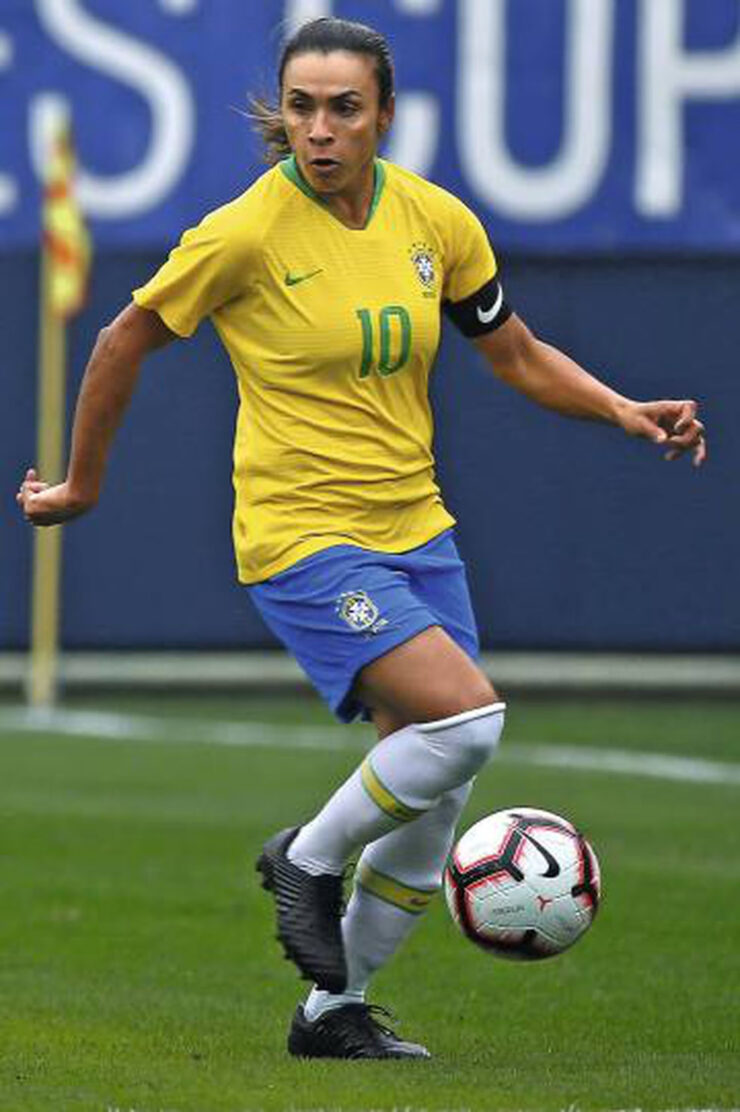The Women’s World Cup is a prestigious international soccer tournament that showcases the immense talent and skills of female football players from around the world. As the popularity and significance of women’s soccer continue to grow, the Women’s World Cup has become a celebrated and highly anticipated event.
In this article, we will delve into the history and evolution of the Cup, explore interesting facts, memorable matches and moments, highlight notable players, and discuss the future of this global tournament.
The Women’s World Cup had humble beginnings, with the inaugural tournament taking place in 1991. Since then, it has grown and expanded, witnessing significant milestones and record-breaking moments.
We will uncover intriguing facts about the Women’s World Cup, including the most successful team, top goal scorers, surprise winners, and the impact it has had on women’s football.
Memorable matches and moments are an integral part of the Cup. From classic finals to stunning upsets, unforgettable goals, and iconic performances, these moments have captivated football fans worldwide and have contributed to the tournament’s legacy.
We will explore the notable players who have made indelible marks in Women’s World Cup history. From record holders and trailblazers to inspirational figures, these players have not only showcased their exceptional skills but have also served as role models for aspiring athletes.
We will discuss the future of the Women’s World Cup and its potential for further growth and development. As women’s soccer continues to gain recognition and support, the Women’s World Cup is poised to become an even more prominent event, fostering increased participation and passion for the sport.
Join us on this exciting journey as we uncover fun facts, relive memorable moments, and celebrate the remarkable achievements of the Women’s World Cup.
History and Evolution of the Women’s World Cup
The history and evolution of the Women’s World Cup takes us on a captivating journey, from its inaugural edition to its remarkable growth and expansion. We’ll delve into the early beginnings of this prestigious tournament and explore how it has evolved over the years.
So, let’s dive into the captivating story behind this iconic competition!
Inaugural Women’s World Cup
The inaugural Women’s World Cup took place in 1991 in China, marking a groundbreaking event that showcased the talent and skill of female athletes on an international stage.
Key facts about the
The tournament featured national teams from China, Norway, Sweden, Brazil, Germany, Italy, Japan, and the United States.
2. The United States emerged as champions: The United States women’s national team won the inaugural Women’s World Cup.
3. Michelle Akers was the top goal scorer: Michelle Akers of the United States scored 10 goals in the tournament.

4. Exciting matches: The Women’s World Cup featured closely contested matches. The final between the United States and Norway ended in a 2-1 victory for the United States.
5. Historic moments: The tournament highlighted the growth and potential of women’s football. It inspired generations of female footballers and laid the foundation for future editions of the Women’s World Cup.
During the Inaugural Women’s World Cup, the United States faced China in a quarterfinal match. The game attracted over 60,000 spectators, making it the largest attendance for a women’s football match at that time. The game ended in a 2-2 draw, and the United States advanced to the semifinals after a penalty shoot-out. This thrilling encounter showcased the excitement and passion surrounding women’s football and demonstrated the growing popularity of the sport.
The Inaugural Women’s World Cup was a significant moment in women’s football history. It showcased the talent and dedication of female footballers and paved the way for the growth and success of the sport on a global scale.
From humble beginnings to a global phenomenon, the Women’s World Cup has grown leaps and bounds, proving that women can dominate the soccer world with style and grace.
Growth and Expansion
The Women’s World Cup demonstrates the increasing popularity and recognition of women’s football worldwide. Here are key highlights:
1. More Participating Teams: The number of teams in the Women’s World Cup has significantly increased. The inaugural tournament in 1991 had 12 teams, while the 2019 edition featured 24 teams. This expansion allows more nations to showcase their talent and promotes global football development.
2. Host Countries: The Women’s World Cup now includes a wider range of host countries. After the initial tournament in China, subsequent editions were held in Sweden, the United States, Germany, Canada, and France. This expansion brings the tournament to new audiences and fosters football growth in different regions.
3. Television Coverage and Global Audience: The Women’s World Cup’s growth is evident in the increasing television coverage and global audience. The tournament is now broadcasted in numerous countries, allowing fans worldwide to watch and support their favorite teams. The 2019 Women’s World Cup attracted a record-breaking global audience of over one billion viewers.
4. Commercial Partnerships and Sponsorships: The Women’s World Cup is supported by a growing number of commercial partnerships and sponsorships. Major brands and companies recognize the value of women’s football, resulting in substantial investments. This financial support contributes to the development of infrastructure, training programs, and grassroots initiatives in women’s football.
5. Development of Women’s Football Federations: The growth of the Women’s World Cup has led to the development of women’s football federations in many countries. National associations are investing in women’s football, providing support and resources to develop players, coaches, and infrastructure. This growth ensures a sustainable future for women’s football globally.
The growth and expansion of the Women’s World Cup cultivate the popularity and acceptance of women’s football worldwide. More teams, increased global audience, and commercial support demonstrate the rising recognition and impact of the tournament. As women’s football continues to flourish, the growth and expansion of the Women’s World Cup will play a crucial role in elevating the sport and inspiring the next generation of players.
The Women’s World Cup has seen surprise winners, record-breaking moments, and unforgettable goals, proving that women’s football is as exciting and entertaining as its male counterpart.
Interesting Facts about the Women’s World Cup
Get ready to uncover some fascinating details about the Women’s World Cup! From the most successful team to record-breaking moments, top goal scorers to surprise winners and underdog stories, and the incredible impact it has had on women’s football, this section is packed with intriguing information. So, hold on tight as we embark on a thrilling journey through the captivating and lesser-known aspects of this prestigious tournament.
Most Successful Team
The United States is the most successful team in the history of the Women’s World Cup. They have won the tournament a record four times in 1991, 1999, 2015, and 2019. No other team has won more than twice. They also finished as runners-up once in 2011, showcasing their strength and competitiveness.
The United States has never finished lower than third place in any Women’s World Cup. They secured third place in 1995, 2003, and 2007. In 2019, the team scored a record-setting 26 goals, the most in a single tournament.
Players like Mia Hamm, Abby Wambach, and Megan Rapinoe have played key roles in the team’s success. Their style of play emphasizes skill, athleticism, and tactical discipline.
The United States has not only achieved success on the field but has also contributed to the growth and development of women’s soccer globally, inspiring a new generation of players and increasing the popularity of the women’s game worldwide.
Top Goal Scorers in Women’s World Cup History
The Women’s World Cup has seen some remarkable goal-scoring legends who have left a significant impact on the tournament. Among them, Marta Vieira da Silva, also known as Marta, stands out as one of the greatest players in the history of the competition. Marta has broken records by scoring an incredible 17 goals in five tournaments, making her the all-time leading goal scorer.
Birgit Prinz, the German forward, has also made a lasting impression on Women’s World Cup history with her impressive goal-scoring ability. Prinz has netted 14 goals in four tournaments and played a pivotal role in Germany’s two World Cup title wins.
Abby Wambach, the American soccer star, is another notable figure in Women’s World Cup history. Wambach has scored 14 goals and her strength in the air has made her a formidable striker. Her performance helped the United States secure the championship in 2015.
Miroslava Klose, a German forward, has demonstrated an incredible ability to score goals by netting 14 goals in three Women’s World Cup appearances. Klose’s clinical finishing and goal-scoring prowess have played a pivotal role in Germany’s success in the tournament.
Maren Meinert, another German forward, has also contributed significantly to Germany’s triumphs in the Women’s World Cup. Meinert’s proficiency in finding the target has resulted in her scoring 13 goals, proving her worth as a lethal striker.
These exceptional goal scorers have solidified their status as legends of the sport by leaving a lasting impact on Women’s World Cup history. Their remarkable skills and ability to score goals have paved the way for new talents to emerge and join the ranks of these esteemed individuals.
Record-breaking Moments
- The Women’s World Cup in China in 1991 marked the beginning of a new era for women’s football on the global stage, with record-breaking moments to come.
- The Women’s World Cup hosted in the United States in 1999 saw the highest attendance in tournament history, with an average of over 37,000 fans per match, making it a series of record-breaking moments. This showed the growing popularity and support for women’s football.
- The Women’s World Cup in Canada in 2015 set a new record for the most goals scored in a single tournament. A total of 146 goals were scored across 52 matches, highlighting the excitement and competitiveness of the tournament, creating record-breaking moments.
- In the same 2015 edition, Carli Lloyd became the first player to score a hat-trick in the final match between the United States and Japan. Her remarkable performance contributed to the United States securing their third Women’s World Cup title, resulting in a record-breaking moment.
- In France in 2019, the Women’s World Cup received unprecedented global attention and media coverage, showcasing the significant progress and growing interest in women’s football worldwide. It was a series of record-breaking moments.
- In the same 2019 edition, the United States team set a new record for the most goals scored by a team in a single tournament, with a total of 26 goals. This surpassed the previous record held by Germany in 2003, marking a record-breaking moment.
- In 2019, Megan Rapinoe became the oldest Golden Boot winner in the history of the Women’s World Cup at the age of 34. Her exceptional performances and goal-scoring prowess earned her this prestigious individual award, contributing to the record-breaking moments of the tournament.
These record-breaking moments highlight the growth and evolution of the Women’s World Cup and the incredible skills of the players who have participated. The tournament continues to captivate global audiences and inspire future generations of female footballers.
From underdog triumphs to surprising upsets, the Women’s World Cup has a knack for turning the football world on its head.
Surprise Winners and Underdog Stories
When it comes to the Women’s World Cup, there have been several surprise winners and underdog stories that captivated fans worldwide. These unexpected victories and inspiring moments showcase the tournament’s unpredictable nature and the ability of lesser-known teams to rise to the challenge. Here are some notable surprise winners and underdog stories from the Women’s World Cup:
- Japan’s Triumph in 2011: Japan emerged as the surprise winners in the 2011 Women’s World Cup by defeating the favored United States team in the final. Their victory not only showcased resilience and determination but also symbolized unity and overcoming adversity.
- Nigeria’s Memorable Run in 1999: Nigeria’s national team, the Super Falcons, made history in the 1999 Women’s World Cup by reaching the quarterfinals. It was the first time an African team achieved such success in the tournament, inspiring future generations of female footballers in Africa.
- Cameroon’s Remarkable Run in 2015: In the 2015 Women’s World Cup, Cameroon captured fans’ hearts with their extraordinary run to the knockout stages. Despite being underdogs, they displayed skill, passion, and a never-give-up attitude, leaving a lasting impact on the tournament.
- Sweden’s Silver Medal in 2003: Sweden surprised everyone in the 2003 Women’s World Cup by reaching the final against Germany. Although they fell short of claiming the title, their remarkable journey showcased their ability to compete at the highest level and challenged the traditional powerhouses.
- Costa Rica’s Historic Quarterfinal Finish in 2014: Costa Rica made their Women’s World Cup debut in 2014 and exceeded expectations by reaching the quarterfinals. Their underdog story highlighted determination and showcased the growing strength of women’s football in Central America.
These surprise winners and underdog stories demonstrate the excitement and unpredictability of the Women’s World Cup. They remind us that anything can happen on the biggest stage of women’s football, inspiring us to believe in the power of perseverance and teamwork.
As you follow the upcoming Women’s World Cup, keep an eye out for potential surprise winners and underdog stories. The tournament has a history of delivering unexpected outcomes and thrilling moments that can change the face of women’s football. Enjoy the journey and embrace the excitement of witnessing new legends being made on the field.
The Women’s World Cup has not only showcased the incredible talent and athleticism of female soccer players, but it has also shattered societal stereotypes and paved the way for greater recognition and support for women’s football.
Impact on Women’s Football
The Women’s World Cup has had a profound impact on women’s football. It has not only increased participation but also cultivated growing support, shattered stereotypes, and inspired role models, all while promoting equality.
This highly anticipated tournament has not only sparked important conversations about gender equality in sports but has also addressed crucial issues such as pay disparity, investment in women’s teams, and representation in leadership positions.
One remarkable story that perfectly showcases the tremendous impact of the Women’s World Cup is the story of Megan Rapinoe.
Following her team’s triumphant victory in the 2019 Women’s World Cup, Rapinoe emerged as a global icon, not only for her exceptional on-field performances but also for her off-field activism.
She has passionately advocated for gender equality, LGBTQ+ rights, and racial justice, making a lasting impact far beyond the realm of football.
The Women’s World Cup has undeniably proven its transformative power in changing lives and empowering communities through the captivating game of football.
Memorable Matches and Moments in Women’s World Cup
Get ready to relive the most memorable matches and moments in the history of the Women’s World Cup! From classic finals to stunning upsets, unforgettable goals to iconic performances, we’ll journey through the heart-pounding excitement that has made this tournament legendary. Get ready to be amazed by the incredible skills, the electric atmosphere, and the unforgettable triumphs that have shaped the Women’s World Cup into the global spectacle it is today. Let’s dive in and celebrate the indelible impact these matches and moments have left on the beautiful game.
Classic Finals
Classic Finals in the Women’s World Cup have provided thrilling and intense moments in the tournament’s history. Here is a table highlighting memorable
| Year | Host Country | Final Match | Champion | Runner-up | Score |
| 1999 | USA | USA vs. China | USA | China | 5-4 (penalties) |
| 2011 | Germany | Japan vs. USA | Japan | USA | 2-2 (3-1 after extra time) |
| 2015 | Canada | USA vs. Japan | USA | Japan | 5-2 |
| 2019 | France | USA vs. Netherlands | USA | Netherlands | 2-0 |
Each of these Classic Finals had unique stories and unforgettable moments. The 1999 final between USA and China is considered one of the greatest matches in Women’s World Cup history. It ended in a penalty shootout, with the USA emerging as champions. The 2011 final saw Japan overcome the USA in a thrilling match that went into extra time. Japan’s victory inspired a nation recovering from a devastating earthquake and tsunami. In 2015, the USA sought revenge against Japan for their 2011 defeat and delivered a dominant performance to win their third title. The most recent Classic Final in 2019 featured the USA facing off against the Netherlands, with the USA securing their fourth title with a solid 2-0 victory.
These Classic Finals showcased the talent, skill, and determination of the teams involved. They provided fans with moments of triumph, heartbreak, and excitement. The Women’s World Cup continues to deliver unforgettable Classic Finals that contribute to the growth and popularity of women’s football worldwide.
When watching future editions of the Women’s World Cup, keep an eye out for the Classic Finals. They are the culmination of hard-fought matches and represent the pinnacle of women’s football. Enjoy the spectacle and witness history in the making!
Stunning Upsets
Stunning upsets have always been a part of the Women’s World Cup, showcasing the tournament’s unpredictability and competitiveness. Over the years, there have been several memorable upsets that have left a lasting impact on the tournament’s history.
One of the most remarkable upsets occurred in 1991 when the United States shocked Norway in the semifinals, emerging victorious with a score of 2-1. Another thrilling upset took place in 1999, as the United States overcame Germany in the quarterfinals, triumphing 3-2 in overtime. In 2011, Japan’s unexpected victory over the United States in the final was considered a major upset. Similarly, in 2015, Colombia put up a strong fight against the United States in the quarterfinals, but ultimately, the United States reigned supreme with a 2-0 win. More recently, in 2019, the Netherlands caused a sensation by upsetting Italy in the quarterfinals, securing a 2-0 victory.
These stunning upsets exemplify the excitement and surprises that make the Women’s World Cup so captivating. They serve as a testament to the competitiveness and determination displayed by underdog teams, proving that anything is possible in the world of women’s soccer.
From long-range screamers to acrobatic volleys, these unforgettable goals in the Women’s World Cup will leave you speechless and the goalkeepers contemplating their life choices.
Unforgettable Goals
Unforgettable Goals are synonymous with the Women’s World Cup. Throughout the tournament’s history, we have witnessed moments of brilliance that will forever be etched in our memories. From Carli Lloyd’s remarkable hat-trick in the 2015 final against Japan to Marta’s exceptional display of skill and speed in 2007, these goals have captivated fans around the world.
https://www.youtube.com/watch?v=mBosyOJ3PIY
In the 2019 Women’s World Cup, Son Heung-min’s stunning long-range strike against Sweden left spectators in awe. The power and precision with which he unleashed the ball into the top corner of the net showcased his shooting ability and technique. And who can forget Abby Wambach’s unforgettable goal in the dying moments of extra time in 2011? Her towering header, equalizing the score and sending the match to a penalty shoot-out, displayed her aerial prowess and ability to rise to the occasion under immense pressure.
But it’s not just individual moments of brilliance that define the Women’s World Cup. In the 1999 final between the United States and China, Brandi Chastain secured victory for her team with a powerful and accurate penalty. Her celebration, captured in an iconic image, became symbolic of Women’s World Cup history.
These unforgettable goals are what make the tournament so captivating. They showcase the skill, athleticism, and determination of the players, leaving a lasting impact on fans and inspiring future generations.
Some performances in the Women’s World Cup are so iconic, they deserve their own theme song.
Iconic Performances
Iconic performances are a highlight of the Women’s World Cup, showcasing the brilliance and skill of the players on the biggest stage. Here are some memorable performances:
1. Marta’s hat-trick in the 2007 Women’s World Cup: Marta, the Brazilian forward, displayed exceptional talent and determination in the quarterfinal match against the United States. She scored a remarkable hat-trick, leading Brazil to a thrilling 4-0 victory over their rivals. Marta’s performance secured their spot in the semifinals and solidified her status as one of the greatest players in women’s football.
2. Carli Lloyd’s hat-trick in the 2015 Women’s World Cup Final: In the final against Japan, Carli Lloyd of the United States gave a masterclass performance. She scored an incredible hat-trick in the first 16 minutes of the match, demonstrating her exceptional skill and composure. Lloyd’s display of talent helped lead her team to a resounding 5-2 victory and their third World Cup title.
3. Abby Wambach’s goal against Brazil in the 2011 Women’s World Cup: In a thrilling quarterfinal match, the United States found themselves trailing 1-2 against Brazil in stoppage time. However, Abby Wambach rescued her team with a sensational header, tying the match and forcing it into extra time. This iconic performance by Wambach not only saved her team from elimination but also inspired a remarkable comeback, ending in a U.S. victory.
4. Hope Solo’s goalkeeping heroics in the 2011 Women’s World Cup: Throughout the tournament, Hope Solo, the American goalkeeper, displayed exceptional skill and agility. Her incredible saves, particularly in crucial moments, played a vital role in the United States’ journey to the final. Solo’s iconic performance in goal was instrumental in their team’s success and earned her the Golden Glove award as the best goalkeeper of the tournament.
5. Birgit Prinz’s dominant displays in the 2003 Women’s World Cup: Birgit Prinz, a German striker, was a force to be reckoned with in the 2003 Women’s World Cup. Prinz led her team to victory with her exceptional goal-scoring ability and leadership on the field. Her iconic performances, including a crucial goal in the final against Sweden, helped Germany secure their first Women’s World Cup title.
These iconic performances have thrilled fans around the world and played a significant role in shaping the history of the Women’s World Cup. They serve as a testament to the skill, determination, and passion of the players who have graced this prestigious tournament.
From record holders to trailblazers, these notable players have left their mark on the Women’s World Cup and continue to inspire future generations of female footballers.
Notable Players in Women’s World Cup History
In the captivating realm of Cup history, we encounter a group of remarkable individuals who have left an indelible mark on the sport. Prepare to be awestruck as we journey through the lives of record holders and trailblazers, whose extraordinary achievements have shaped the very fabric of this illustrious tournament. We will be introduced to inspirational figures whose impact extends far beyond the football pitch. Get ready to meet the legends who have propelled the Women’s World Cup to new heights.
Record Holders and Trailblazers
The table below displays notable record holders and trailblazers in the Women’s World Cup.
| Category | Record Holder/Trailblazer |
|---|---|
| Most Goals in a Single Tournament | Marta (Brazil) – 7 goals in the 2007 Women’s World Cup |
| Most Goals Overall | Marta (Brazil) – 17 goals across multiple tournaments |
| Most World Cup | United States – 4 wins in 1991, 1999, 2015, and 2019 |
| Most World Cup Appearances | Brazil and Germany – 8 appearances each |
| Oldest Goal Scorer | Cristiane (Brazil) – Scored a goal at 34 years and 25 days in 2019 |
| Youngest Goal Scorer | Leena Khamis (Australia) – Scored a goal at 16 years and 331 days in 2011 |
| First Goal in Women’s World Cup History | Sylvia Neid (Germany) – Scored the inaugural goal in the 1991 Women’s World Cup |

Despite the impact of these record holders and trailblazers, many other talented players and teams have contributed to the tournament’s growth and success.
One inspiring trailblazer is Homare Sawa from Japan. Sawa holds the record for the oldest player to win the FIFA Women’s World Cup. At 33 years old, she led her team to victory in the 2011 tournament, where she also won the Golden Boot as the top goal scorer and the Golden Ball as the tournament’s best player. Sawa’s skill, determination, and leadership have inspired female footballers around the world.
These record holders and trailblazers showcase the incredible talent and achievements in the Women’s World Cup, paving the way for the growth and recognition of women’s football globally.
Inspirational Figures: These women have shown the world that they can kick butt on and off the field, serving as role models for aspiring athletes everywhere.
Inspirational Figures
Inspiring figures have played a significant role in shaping and elevating the Women’s World Cup. They have showcased exceptional skills on the field and become role models for future generations.
1. Mia Hamm: One of the greatest female footballers of all time, Mia Hamm’s impact on the sport is undeniable. As a key member of the United States national team, she led the team to victory in two Women’s World Cups (1991 and 1999). Hamm’s skills and determination paved the way for future female footballers.
2. Marta Vieira da Silva: Known as Marta, this Brazilian superstar has dominated the Women’s World Cup stage. Marta has the all-time leading goal scorer record in Women’s World Cup history. Her technical abilities and dedication make her an inspiration for aspiring female athletes.

3. Abby Wambach: A powerhouse on the field, Abby Wambach’s leadership and goal-scoring prowess have left a lasting impact on women’s football. Her iconic header goal in the 2011 Women’s World Cup quarterfinals is one of the tournament’s most memorable moments.
4. Homare Sawa: The Japanese midfielder captivated the world in the 2011 Women’s World Cup. Sawa’s skills and leadership helped Japan secure their first-ever World Cup title against the odds. Her resilience and determination serve as an inspiration to players worldwide.
5. Sun Wen: Regarded as one of China’s greatest female footballers, Sun Wen’s contributions to the game are significant. She played a crucial role in China’s runner-up finish in the 1999 Women’s World Cup and raised the profile of women’s football in her country.
These inspirational figures have not only achieved success on the field but have also advocated for gender equality in sports. Their dedication, talent, and passion have enhanced women’s football and inspired players to pursue their goals.
Nadia Nadim, a Danish footballer, is an inspirational figure who has overcome immense challenges. Nadim’s journey began as a refugee escaping the Taliban in Afghanistan. Through persistence and determination, she represented Denmark in the Women’s World Cup. Her story inspires others to overcome obstacles and pursue their dreams.
Future of the Women’s World Cup
“The future of the Women’s World Cup looks promising, with exciting developments and opportunities on the horizon. There are several key factors to consider that contribute to this bright outlook.
There has been a notable increase in the participation of teams in the Women’s World Cup. In 2019, the tournament saw 24 teams competing, a significant rise from the 12 teams in 1991. This upward trend is expected to continue as more countries invest in women’s football, further expanding the pool of participating nations.
The Women’s World Cup has been attracting growing viewership and commercial success. The 2019 edition reached a global cumulative audience of over 1 billion viewers, setting new records. This surge in viewership creates numerous commercial opportunities, with sponsors and broadcasters increasingly supporting women’s football.
Hosting the Women’s World Cup necessitates investment in infrastructure such as stadiums, training facilities, and accommodation. As women’s football gains popularity, countries are willing to invest in top-quality venues, further enhancing the tournament experience.
Efforts are also being made to address the issue of pay parity in women’s football. Discussions are ongoing to close the pay gap and provide equal opportunities and rewards for female players.
The Women’s World Cup champions gender equality and women’s rights, gaining recognition and support on a global scale. Influential organizations and individuals are backing women’s sport and advocating for a more inclusive world. This widespread support will undoubtedly shape the future of the tournament.
The 9th edition of the Women’s World Cup is scheduled to take place in Australia and New Zealand from July 20th to August 20th, 2024.
- ✅ The largest attendance in Women’s World Cup history was in Canada in 2015, with 1,353,506 people attending the matches.
- ✅ The Brazilian women’s team has never won the World Cup, with their best finish being runner-up in 2007.
- ✅ The United States have won the Women’s World Cup four times (1991, 1999, 2015, 2019), making them the most successful team.
- ✅ Two Women’s World Cup finals have been decided by penalty shootouts, with the US winning in 1999 and Japan winning in 2011.
- ✅ The 2024 Women’s World Cup will feature 32 teams, the largest field in tournament history.
Frequently Asked Questions
What is the Women’s World Cup?
The Women’s World Cup is a world-class football tournament, equivalent to the men’s edition, where national women’s football teams from around the globe compete for the championship title.
When was the first edition of the Women’s World Cup held?
The first edition of the Women’s World Cup was held in 1991 in Guangdong, China.
Which nation has the most titles in the Women’s World Cup?
The United States holds the record for the most titles in the Women’s World Cup, winning a total of four championships.
Will the 2024 Women’s World Cup be different from previous editions?
Yes, the 2024 Women’s World Cup will witness some significant changes. It will be jointly hosted by Australia and New Zealand, making it the first-ever dual-hosted women’s tournament. The number of participating nations will increase to 32, which is an expansion from the previous 24.
Who is the all-time top scorer in the Women’s World Cup?
Marta Vieira da Silva from Brazil is the all-time top scorer in the Women’s World Cup, with a remarkable 17 goals to her name.
Which teams will be making their debut in the 2024 Women’s World Cup?
Several nations, including the Philippines, Vietnam, Morocco, Zambia, Haiti, Panama, Portugal, and the Republic of Ireland, will be making their World Cup debut in the 2024 edition.












